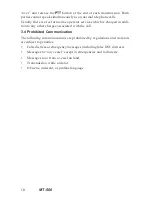
MT-500
11
4. INSTALLATION
4.1 Transceiver
Your MT-500 Transceiver is designed to withstand the rigors of the marine
environment. However, selecting a mounting location affording some protec-
tion from the elements will prolong the life of connectors, controls and the
liquid crystal display (LCD).
Select a location within easy reach and view of the operator and away from
your vessel’s compass. Locate the microphone to avoid entanglement with
steering or engine controls, both when in use and when stowed. Also, con-
sider routing of antenna, power and NMEA interface cables. Mount the trans-
ceiver securely to a solid surface.
4.2 Antenna
Proper installation of a quality VHF antenna is very important to reliable
radio communication. A good quality unity gain antenna is recommended
for maximum range performance. In general, antennas should be located as
high as practical and separated as much as possible from other antennas and
structures. The minimum distance to other objects is 1 meter. Route the an-
tenna cable away from other electronic equipment and do not bundle the
antenna or power cable with other wiring, especially transducer cables for
depth sounders and fish finders. For cables longer than 10 meters, RG-8/U
coaxial cable must be used. Mount the antenna and install the connector(s) in
accordance with manufacturers instructions. Connect the antenna cable to
the RF output connector on the rear panel of the transceiver.
4.3 Power Connection
CAUTION
Reverse polarity connections can damage your transceiver
The power cable for you transceiver must be connected to the ships main
power buss. Use the 6.3 Amp in-line fuse provided. Connect the Red wire to
the positive (+) terminal and the Black wire to the negative (—) terminal.
Connect the barrel terminals on the power cable to the matching color wires
and terminals extending from the rear panel of the transceiver.
Содержание MT-500
Страница 56: ...MT 500 55 9 3 Troubleshooting...
Страница 62: ...MT 500 61 Table 1 of 2...
Страница 63: ...62 MT 500 Table 2 of 2...













































